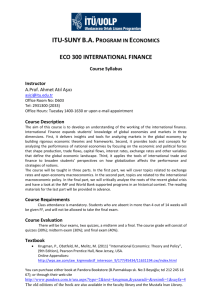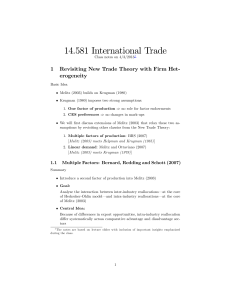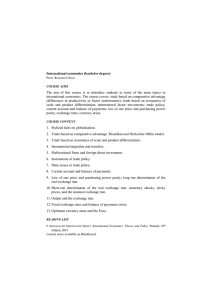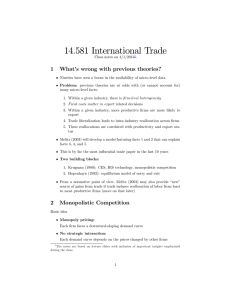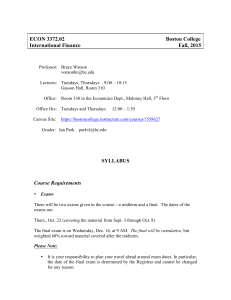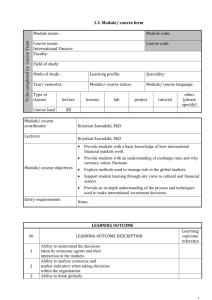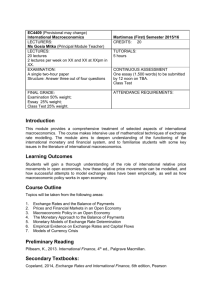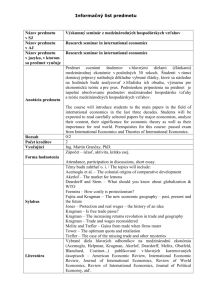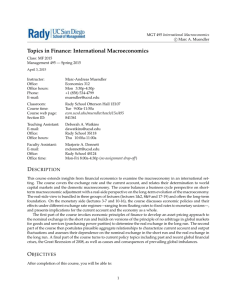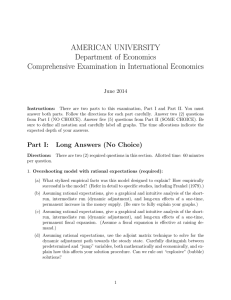14.581 International Trade — Lecture 14: Firm Heterogeneity Theory (I) — 14.581
advertisement
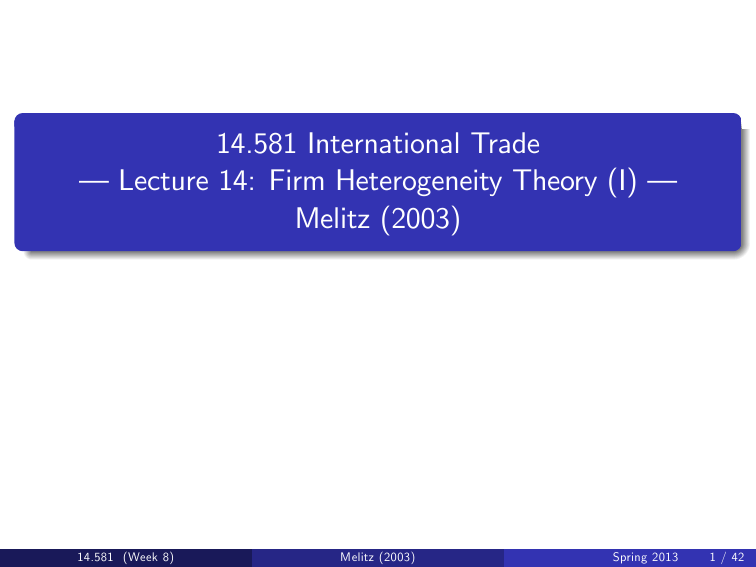
14.581 International Trade — Lecture 14: Firm Heterogeneity Theory (I) — Melitz (2003) 14.581 Week 8 Spring 2013 14.581 (Week 8) Melitz (2003) Spring 2013 1 / 42 Firm-Level Heterogeneity and Trade What’s wrong with previous theories? Nineties have seen a boom in the availability of micro-level data Problem: previous theories are at odds with (or cannot account for) many micro-level facts: 1 2 3 4 5 Within a given industry, there is …rm-level heterogeneity Fixed costs matter in export related decisions Within a given industry, more productive …rms are more likely to export Trade liberalization leads to intra-industry reallocation across …rms These reallocations are correlated with productivity and export status 14.581 (Week 8) Melitz (2003) Spring 2013 2 / 42 Firm-Level Heterogeneity and Trade What does Melitz (2003) do about it? Melitz (2003) will develop a model featuring facts 1 and 2 that can explain facts 3, 4, and 5 This is by far the most in‡uential trade paper in the last 10 years Two building blocks: 1 2 Krugman (1980): CES, IRS technology, monopolistic competition Hopenhayn (1992): equilibrium model of entry and exit From a normative point of view, Melitz (2003) may also provide “new” source of gains from trade if trade induces reallocation of labor from least to most productive …rms (more on that later) 14.581 (Week 8) Melitz (2003) Spring 2013 3 / 42 Today’s Plan 1 A Refresher on Monopolistic Competition 1 2 2 Krugman (1979) An Important Special Case: CES Utility Melitz (2003) 1 2 Krugman (1980) meets Hopenhayn (1992) Selection into Exports and the Impact of Trade 14.581 (Week 8) Melitz (2003) Spring 2013 4 / 42 Monopolistic Competition Basic idea Monopoly pricing: Each …rm faces a downward-sloping demand curve No strategic interaction: Each demand curve depends on the prices charged by other …rms but since the number of …rms is large, each …rm ignores its impact on the demand faced by other …rms Free entry: Firms enter the industry until pro…ts are driven to zero for all …rms 14.581 (Week 8) Melitz (2003) Spring 2013 5 / 42 Monopolistic Competition Graphical analysis p AC MC MR D q 14.581 (Week 8) Melitz (2003) Spring 2013 6 / 42 Krugman (1979) Endowments, preferences, and technology Endowments: All agents are endowed with 1 unit of labor Preferences: All agents have the same utility function given by Rn U = 0 u (ci ) di where: u (0) = 0, u 0 > 0, and u 00 < 0 (love of variety) u0 0 σ (c ) 0 (why?) cu 00 > 0 is such that σ IRS Technology: Labor used in the production of each “variety” is li = f + qi /ϕ where ϕ 14.581 (Week 8) common productivity parameter Melitz (2003) Spring 2013 7 / 42 Krugman (1979) Equilibrium conditions 1 Consumer maximization: pi = λ 2 σ ( ci ) σ ( ci ) 1 w ϕ Free entry: pi 4 u ( ci ) Pro…t maximization: pi = 3 1 0 w ϕ qi = wf Good and labor market clearing: qi = Lci L = nf + 14.581 (Week 8) Melitz (2003) R n qi di 0 ϕ Spring 2013 8 / 42 Krugman (1979) Equilibrium conditions rearranged Symmetry ) pi = p, qi = q, and ci = c for all i 2 [0, n] c and p/w are simultaneously characterized by (PP): (ZP): σ (c ) 1 p = w σ (c ) 1 ϕ p f 1 f 1 = + = + w q ϕ Lc ϕ n can then be computed using market clearing conditions n= 14.581 (Week 8) 1 f /L + c/ϕ Melitz (2003) Spring 2013 9 / 42 Krugman (1979) Graphical analysis p/w Z P (p/w)0 Z P c0 14.581 (Week 8) Melitz (2003) c Spring 2013 10 / 42 Krugman (1979) Gains from trade revisited p/w Z P Z’ (p/w)0 (p/w)1 Z P Z’ c1 c0 c Suppose that two identical countries open up to trade This is equivalent to a doubling of country size (which would have no e¤ect in a neoclassical trade model) Because of IRS, opening up to trade now leads to: 1 1 Increased product variety: c1 < c0 ) f /2L + c1 /ϕ > f /L +c0 /ϕ Pro-competitive/e¢ ciency e¤ects: (p/w )1 < (p/w )0 ) q1 > q0 14.581 (Week 8) Melitz (2003) Spring 2013 11 / 42 CES Utility Trade economists’most preferred demand system Constant Elasticity of Substitution (CES) utility corresponds to the case where: Rn σ 1 U = 0 (ci ) σ di, where σ > 1 is the elasticity of substitution between pair of varieties This is the case considered in Krugman (1980) What is it to like about CES utility? σ 1 Homotheticity (u (c ) (c ) σ is actually the only functional form such that U is homothetic) Can be derived from discrete choice model with i.i.d extreme value shocks (See Feenstra Appendix B) Is it empirically reasonable? 14.581 (Week 8) Melitz (2003) Spring 2013 12 / 42 CES Utility Special properties of the equilibrium Because of monopoly pricing, CES ) constant markups: p σ = w σ 1 1 ϕ Because of zero pro…t, constant markups ) constant output per …rm: p f 1 = + w q ϕ Because of market clearing, constant output per …rm ) constant number of varieties per country: L n= f + q/ϕ So, gains from trade only come from access to Foreign varieties IRS provide an intuitive reason why Foreign varieties are di¤erent But consequences of trade would now be the same if we had maintained CRS with di¤erent countries producing di¤erent goods 14.581 (Week 8) Melitz (2003) Spring 2013 13 / 42 CES Utility Special properties of the equilibrium Decentralized equilibrium is e¢ cient Decentralized equilibrium solves: max q i ,n subject to : Rn 0 nf + A central planner would solve: max q i ,n 1 Under CES, pi (qi ) qi ∝ qi 1 σ R n qi di 0 ϕ Rn nf + subject to: pi (qi ) qi di 0 (qi ) σ 1 σ R n qi di 0 ϕ L. di L. ) Two solutions coincide This is unique to CES (in general, entry is distorted) This implies that many properties of perfectly competitive models will carry over to this environment 14.581 (Week 8) Melitz (2003) Spring 2013 14 / 42 Melitz (2003) Demand Like in Krugman (1980), representative agent has CES preferences: U= Z ω 2Ω q (ω ) σ 1 σ σ σ 1 dω where σ > 1 is the elasticity of substitution Consumption and expenditures for each variety are given by σ p (ω ) q (ω ) = Q P r (ω ) = R p (ω ) P (1) 1 σ (2) where: P Z ω 2Ω 14.581 (Week 8) p (ω ) 1 σ 1 1 σ dω ,R Melitz (2003) Z ω 2Ω r (ω ) , and Q R/P Spring 2013 15 / 42 Melitz (2003) Production Like in Krugman (1980), labor is the only factor of production L total endowment, w = 1 wage Like in Krugman (1980), there are IRS in production l = f + q/ϕ (3) Like in Krugman (1980), monopolistic competition implies p ( ϕ) = 1 ρϕ (4) CES preferences with monopoly pricing, (2) and (4), imply r ( ϕ) = R (Pρϕ)σ 1 (5) These two assumptions, (3) and (4), further imply π ( ϕ) 14.581 (Week 8) r ( ϕ) l ( ϕ) = Melitz (2003) r ( ϕ) σ f Spring 2013 16 / 42 Melitz (2003) Production Comments: 1 Higher productivity ϕ in the model implies higher measured productivity r ( ϕ) 1 1 = l ( ϕ) ρ 2 More productive …rms produce more and earn higher revenues q ( ϕ1 ) = q ( ϕ2 ) 3 f l ( ϕ) ϕ1 ϕ2 σ and r ( ϕ1 ) = r ( ϕ2 ) ϕ1 ϕ2 σ 1 ϕ can also be interpreted in terms of quality. This is isomorphic to a change in units of account, which would a¤ect prices, but nothing else 14.581 (Week 8) Melitz (2003) Spring 2013 17 / 42 Melitz (2003) Aggregation By de…nition, the CES price index is given by P= Z ω 2Ω p (ω ) 1 σ 1 1 σ dω Since all …rms with productivity ϕ charge the same price p ( ϕ), we can rearrange CES price index as P= Z +∞ 0 p ( ϕ) 1 σ 1 1 σ Mµ ( ϕ) d ϕ where: M mass of (surviving) …rms in equilibrium µ ( ϕ) (conditional) pdf of …rm-productivity levels in equilibrium 14.581 (Week 8) Melitz (2003) Spring 2013 18 / 42 Melitz (2003) Aggregation Combining the previous expression with monopoly pricing (4), we get 1 ϕ P = M 1 σ /ρe where e ϕ Z +∞ 0 ϕ σ 1 1 σ 1 µ ( ϕ) d ϕ One can do the same for all aggregate variables σ R = Mr ( e ϕ) , Π = Mπ ( e ϕ) , Q = M σ 1 q ( e ϕ) Comments: 1 2 These are the same aggregate variables we would get in a Krugman (1980) model with a mass M of identical …rms with productivity e ϕ But productivity e ϕ now is an endogenous variable which may respond to changes in trade cost, leading to aggregate productivity changes 14.581 (Week 8) Melitz (2003) Spring 2013 19 / 42 Melitz (2003) Entry and exit In order to determine how µ ( ϕ) and e ϕ get determine in equilibrium, one needs to specify the entry and exit of …rms Timing is similar to Hopenhayn (1992): 1 2 3 4 There is a large pool of identical potential entrants deciding whether to become active or not Firms deciding to become active pay a …xed cost of entry fe > 0 and get a productivity draw ϕ from a cdf G After observing their productivity draws, …rms decide whether to remain active or not Firms deciding to remain active exit with a constant probability δ 14.581 (Week 8) Melitz (2003) Spring 2013 20 / 42 Melitz (2003) Aside: Pareto distributions In variations and extensions of Melitz (2003), most common assumption on the productivity distribution G is Pareto: G ( ϕ) 1 g ( ϕ) θ ϕθ ϕ ϕ θ for ϕ ϕ θ 1 for ϕ ϕ ϕ Pareto distributions have two advantages: 1 2 Combined with CES, it delivers closed form solutions Distribution of …rm sizes remains Pareto, which is not a bad approximation empirically (at least for the upper tail) But like CES, Pareto distributions will have very strong implications for equilibrium properties (more on this later) 14.581 (Week 8) Melitz (2003) Spring 2013 21 / 42 Melitz (2003) Productivity cuto¤ In a stationary equilibrium, a …rm either exits immediately or produces and earns the same pro…ts π ( ϕ) in each period In the absence of time discounting, expected value of a …rm with productivity ϕ is v ( ϕ) = max 0, ∑t+=∞0 (1 δ)t π ( ϕ) = max 0, There exists a unique productivity level ϕ Productivity cuto¤ ϕ can also be written as: n inf ϕ π ( ϕ) δ 0: π ( ϕ) δ >0 o π (ϕ ) = 0 14.581 (Week 8) Melitz (2003) Spring 2013 22 / 42 Melitz (2003) Aggregate productivity Once we know ϕ , we can compute the pdf of …rm-productivity levels ( g ( ϕ) if ϕ ϕ 1 G (ϕ ) µ ( ϕ) = 0 if ϕ < ϕ Accordingly, the measure of aggregate productivity is given by e ϕ (ϕ ) = 14.581 (Week 8) 1 1 G (ϕ ) Z +∞ ϕ σ 1 1 σ 1 g ( ϕ) d ϕ ϕ Melitz (2003) Spring 2013 23 / 42 Melitz (2003) Free entry condition Let π Π/M denote average pro…ts per period for surviving …rms Free entry requires the total expected value of pro…ts to be equal to the …xed cost of entry 0 G (ϕ ) + π δ [1 G ( ϕ )] = fe Free Entry Condition (FE): π= 1 δfe G (ϕ ) (6) Holding constant the …xed costs of entry, if …rms are less likely to survive, they need to be compensated by higher average pro…ts 14.581 (Week 8) Melitz (2003) Spring 2013 24 / 42 Melitz (2003) Zero cuto¤ pro…t condition De…nition of ϕ can be rearranged to obtain a second relationship between ϕ and π By de…nition of π, we know that π = Π/M = π [ e ϕ ( ϕ )] , π = f By de…nition of ϕ , we know that r [e ϕ ( ϕ )] σf 1 π ( ϕ ) = 0 , r ( ϕ ) = σf Two previous expressions imply ZCP condition: " e r [e ϕ ( ϕ )] ϕ (ϕ ) π=f 1 =f r (ϕ ) ϕ 14.581 (Week 8) Melitz (2003) σ 1 1 # Spring 2013 (7) 25 / 42 Melitz (2003) Closed economy equilibrium (FRQRPHWULF6RFLHW\$OOULJKWVUHVHUYHG7KLVFRQWHQWLVH[FOXGHGIURPRXU&UHDWLYH &RPPRQVOLFHQVH)RUPRUHLQIRUPDWLRQVHHKWWSRFZPLWHGXIDLUXVH 14.581 (Week 8) Melitz (2003) Spring 2013 26 / 42 Melitz (2003) Aside: the shape of the ZCP schedule FE and ZCP, (6) and (7), determine a unique (π, ϕ ), and therefore e ϕ, independently of country size L the only variable left to compute is M, which can be done using free entry and labor market clearing as in Krugman (1980) However, ZCP is not necessarily downward sloping: it depends on whether e ϕ or ϕ increases relatively faster ZCP is downward sloping for most common distributions In the Pareto case, it is easy to check that e ϕ/ϕ is constant: So ZCP is ‡at and average pro…ts are independent of ϕ 14.581 (Week 8) Melitz (2003) Spring 2013 27 / 42 Melitz (2003) Number of varieties and welfare Free entry and labor market clearing imply L = R = rM We can rearrange the previous expression M= L L = r σ (π + f ) Like in Krugman (1980), welfare of a representative worker is given by 1 U = 1/P = M σ 1 ρe ϕ Since e ϕ and π are independent of L, growth in country size and costless trade will also have the same impact as in Krugman (1980): welfare % because of % in total number of varieties in each country 14.581 (Week 8) Melitz (2003) Spring 2013 28 / 42 Melitz (2003) Open economy model In the absence of trade costs, we have seen trade integration does not lead to any intra-industry reallocation (e ϕ is …xed) In order to move away from such (counterfactual) predictions, Melitz (2003) introduces two types of trade costs: 1 2 Iceberg trade costs: in order to sell 1 unit abroad, …rms need to ship τ 1 units Fixed exporting costs: in order to export abroad, …rms must incur an additional …xed cost fex (information, distribution, or regulation costs) after learning their productivity ϕ In addition, Melitz (2003) assumes that c = 1, ..., n countries are symmetric so that wc = 1 in all countries 14.581 (Week 8) Melitz (2003) Spring 2013 29 / 42 Melitz (2003) Production Monopoly pricing now implies pd ( ϕ) = 1 τ , px ( ϕ) = ρϕ ρϕ Revenues in the domestic and export markets are rd ( ϕ) = Rd [Pd ρϕ]σ 1 , rx ( ϕ) = τ 1 σ Rx [Px ρϕ]σ 1 Note that by symmetry, we must have Pd = Px = P and Rd = Rx = R Let fx δfex . Pro…ts in the domestic and export markets are π d ( ϕ) = 14.581 (Week 8) rd ( ϕ) σ f , π x ( ϕ) = Melitz (2003) rx ( ϕ) σ fx Spring 2013 30 / 42 Melitz (2003) Productivity cuto¤s Expected value of a …rm with productivity ϕ is v ( ϕ) = max 0, ∑t+=∞0 (1 δ)t π ( ϕ) = max 0, π ( ϕ) δ But total pro…ts of are now given by π ( ϕ) = π d ( ϕ) + max f0, π x ( ϕ)g o n π ( ϕ) Like in the closed economy, we let ϕ inf ϕ 0 : δ > 0 n o π ( ϕ) In addition, we let ϕx inf ϕ ϕ : x δ > 0 be the export cuto¤ In order to have both exporters and non-exporters in equilibrium, ϕx > ϕ , we assume that: τσ 14.581 (Week 8) 1 fx > f Melitz (2003) Spring 2013 31 / 42 Melitz (2003) Selection into exports π Exit Don’t Export Export πD πX 0 (ϕ*)σ−1 (ϕ*x)σ−1 (ϕ)σ−1 -fD -fX Image by MIT OpenCourseWare. 14.581 (Week 8) Melitz (2003) Spring 2013 32 / 42 Melitz (2003) Are exporters more productive than non-exporters? In the model, more productive …rms (higher ϕ) select into exports Empirically, this directly implies larger …rms (higher r ( ϕ)) Question: Does that also mean that …rms with higher measured productivity select into exports? Answer: Yes. For this to be true, we need rd ( ϕ) + nrx ( ϕ) r ( ϕ) > d , ld ( ϕ) + nlx ( ϕ) ld ( ϕ) 1f >f Comment: Like in the closed economy, this crucially relies on the fact that …xed labor costs enter the denominator which always holds if τ σ 14.581 (Week 8) x Melitz (2003) Spring 2013 33 / 42 Melitz (2003) Aggregation In the open economy, aggregate productivity is now given by e ϕt = where: Mt e ϕ= 1 h Me ϕσ Mt 1 + nMx ( e ϕx /τ ) σ 1 i 1 σ 1 M + nMx is the total number of varieties Z +∞ 1 ϕσ 1 g 1 G (ϕ ) ϕ 1 σ 1 ( ϕ) d ϕ across all …rms e ϕx = Z +∞ 1 ϕσ 1 g 1 G ( ϕx ) ϕ x is the average productivity 1 σ 1 ( ϕ) d ϕ is the average productivity across all exporters 14.581 (Week 8) Melitz (2003) Spring 2013 34 / 42 Melitz (2003) Aggregation Once we know e ϕt , we can still compute all aggregate variables as: 1 = Mt1 σ /ρe ϕt , R = Mt r ( e ϕt ) , Π = Mt π ( e ϕt ) , P σ Q Comment: = Mtσ 1 q ( e ϕt ) Like in the closed economy, there is a tight connection between welfare (1/P) and average productivity (e ϕt ) But in the open economy, this connection heavily relies on symmetry: welfare depends on the productivity of foreign, not domestic exporters 14.581 (Week 8) Melitz (2003) Spring 2013 35 / 42 Melitz (2003) Free entry condition The condition for free entry is unchanged Free Entry Condition (FE): π= 1 δfe G (ϕ ) (8) The only di¤erence is that average pro…ts now depend on export pro…ts as well π = πd ( e ϕ) + npx π x ( e ϕx ) where: px = 1 G ( ϕx ) 1 G (ϕ ) 14.581 (Week 8) is probability of exporting conditional on successful entry Melitz (2003) Spring 2013 36 / 42 Melitz (2003) Zero cuto¤ pro…t condition By de…nition of the cut o¤ productivity levels, we know that π d ( ϕ ) = 0 , rd ( ϕ ) = σf π x ( ϕx ) = 0 , rx ( ϕx ) = σfx This implies rx ( ϕx ) fx = , ϕx = ϕ τ rd ( ϕ ) f fx f 1 σ 1 By rearranging π as a function of ϕ , we new ZCP condition: # " " # e ϕx ( ϕ ) σ 1 e ϕ (ϕ ) σ 1 π=f 1 + npx fx 1 ϕ ϕx ( ϕ ) 14.581 (Week 8) Melitz (2003) Spring 2013 37 / 42 Melitz (2003) The Impact of Trade Free entry π _ π _ πa Trade Zero cutoff profit δfa Autarky ϕa ϕ ϕ Image by MIT OpenCourseWare. 14.581 (Week 8) Melitz (2003) Spring 2013 38 / 42 Melitz (2003) The Impact of Trade In line with empirical evidence, exposure to trade forces the least productive …rms to exit: ϕ > ϕa Intuition: For exporters: Pro…ts % due to export opportunities, but & due to the entry of foreign …rms in the domestic market (P &) For non-exporters: only the negative second e¤ect is active Comments: The % in ϕ is not a new source of gains from trade. It’s because there are gains from trade (P &) that ϕ %increases Welfare unambiguously % though number of domestic varieties & M= 14.581 (Week 8) R L = < Ma r σ (π + f + px nfx ) Melitz (2003) Spring 2013 39 / 42 Melitz (2003) The Impact of Trade π π πD πX 0 (ϕ*)σ−1 (ϕ*x)σ−1 (ϕ)σ−1 -fD -fX Image by MIT OpenCourseWare. 14.581 (Week 8) Melitz (2003) Spring 2013 40 / 42 Melitz (2003) The Impact of Trade Lose Market Share Gain Market Share π πa π πD πX (ϕ*a)σ−1 0 (ϕ∗)σ−1 (ϕ)σ−1 (ϕ∗x)σ−1 -fD -fX Image by MIT OpenCourseWare. 14.581 (Week 8) Melitz (2003) Spring 2013 41 / 42 Melitz (2003) Other comparative static exercises Starting from autarky and moving to trade is theoretically standard, but not empirically appealing Melitz (2003) also considers: 1 2 3 Increase in the number of trading partners n Decrease in iceberg trade costs τ Decrease in …xed exporting costs fx Same qualitative insights in all scenarios: Exit of least e¢ cient …rms Reallocation of market shares from less from more productive …rms Welfare gains 14.581 (Week 8) Melitz (2003) Spring 2013 42 / 42 MIT OpenCourseWare http://ocw.mit.edu 14.581 International Economics I Spring 2013 For information about citing these materials or our Terms of Use, visit: http://ocw.mit.edu/terms.
